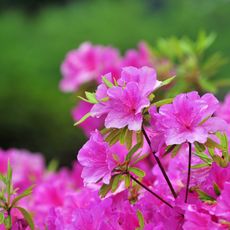Information About Striped-Leafed Japanese Maize
Often we are gardening towards a purpose, maybe for cheaper or organically grown food. Perhaps we garden to shade our homes or to shield ourselves from the prying eyes of the nosy neighbor. But sometimes, there is just no denying the nut in us and we just want to have fun. Boy do I have a plant for those times! Have a look at Striped-Leafed Japanese maize.
Japonica Striped Maize Plant History
The heirloom corn that comes in a rainbow of colors offer gardeners more than just good flavor - you also get something attractive to plant and an interesting history. Speaking of which, it's believed that corn's origin began in the Mexican plateau or highlands of Guatemala, with maize being domesticated in the Tehuacan Valley of Mexico. Maize gets its name from a Spanish deviation for the word 'plant.' Maize, like other corn varieties, spread to the rest of the world through trading and exploration. Japanese Striped maize (Zea mays 'Japonica') is an amazing, visually stunning ornamental corn plant hailing from, you guessed it, Japan. Introduced in the 1890's, it might just as well have been called "Rainbow Striped maize" due to its multi-hued foliage and tassels. Japonica striped maize plant has variegated leaves striped with green, yellow, pink and white with dark purple tassels and burgundy kernels. Talk about eye popping!
Growing Japanese Striped Maize
What's that you say? How do you grow the heirloom striped-leafed Japanese maize? This exquisite corn specimen is grown just as you would any other corn. Sow seeds outdoors at a depth of 1 inch after all danger of frost has passed in soil amended with compost and of a pH between 6.0 and 6.8. Choose a sunny location and set seeds in blocks of 3-6 rows, rather than one long row. This will increase the chances for pollination, and widely spaced plants tend to develop more intense colors. Thin the seedlings to a foot apart. A small side note. Corn varieties easily cross pollinate, so separate them by at least 100 feet. Otherwise, who knows what you will end up growing! Of course, that in itself could be interesting too. Remember, corn in general is a heavy feeder. Companion plantings of beans can encourage growth. Squash suppresses weeds, and peas planted along with corn add nitrogen to the soil. In fact, the combination of corn, squash and beans is one of the first companion plantings practiced by Native American people and is referred to as the "Three Sisters Garden," because these three plants should never be parted. In about 85 days, you will be enjoying the brilliant, colorful foliage (5-6 feet tall), but not only you. The neat thing about this annual is that the critters love it too. Ok, maybe they aren't admiring its coloration, but the small burgundy ears are definitely tasty treats for all kinds of birds. See, you ended up planting Japanese striped maize for a reason. Not so crazy after all.
Gardening tips, videos, info and more delivered right to your inbox!
Sign up for the Gardening Know How newsletter today and receive a free copy of our e-book "How to Grow Delicious Tomatoes".

Amy Grant has been gardening for 30 years and writing for 15. A professional chef and caterer, Amy's area of expertise is culinary gardening.
-
 Ideal Azalea Water Requirements – For Lush, Healthy Shrubs That Will Thrive For Years
Ideal Azalea Water Requirements – For Lush, Healthy Shrubs That Will Thrive For YearsWhat are an azalea's water requirements? Learn how to keep these beautiful spring-blooming shrubs happy and healthy in your yard or container garden.
By Amy Grant
-
 7 Vegetables To Plant In April: Start Indoors Or Outside For A Bumper Summer Harvest
7 Vegetables To Plant In April: Start Indoors Or Outside For A Bumper Summer HarvestAchieve your growing ambitions with these best vegetables to plant in April – including cold-hardy crops to sow direct and tender varieties to start indoors
By Mary Ellen Ellis
